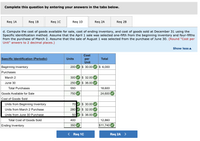
FINANCIAL ACCOUNTING
10th Edition
ISBN: 9781259964947
Author: Libby
Publisher: MCG
expand_more
expand_more
format_list_bulleted
Question
thumb_up100%
How do we get 70, 280, and 50? Please show me the work and explanation. Thanks!

Transcribed Image Text:Scrappers Supplies tracks the number of units purchased and sold throughout each accounting period but applies its inventory costing
method at the end of each period, as if it uses a periodic inventory system. Assume its accounting records provided the following
information at the end of the annual accounting period, December 31.
Unit
Transactions
Units
Cost
Beginning inventory, January 1
Transactions during the year:
a. Purchase on account, March 2
b. Cash sale, April 1 ($46 each)
c. Purchase on account, June 30
d. Cash sale, August 1 ($46 each)
200
$30
300
32
(350)
250
36
(50)
TIP: Although the purchases and sales are listed in chronological order, Scrappers determines the cost of goods sold after all of the
purchases have occurred.
Required:
1. Compute the cost of goods available for sale, cost of ending inventory, and cost of goods sold at December 31 under each of the
following inventory costing methods:
a. Last-in, first-out.
b. Weighted average cost.
c. First-in, first-out.
d. Specific identification, assuming that the April 1 sale was selected one-fifth from the beginning inventory and four-fifths from the
purchase of March 2. Assume that the sale of August 1 was selected from the purchase of June 30.
2. Of the four methods, which will result in the highest gross profit? Which will result in the lowest income taxes?

Transcribed Image Text:Complete this question by entering your answers in the tabs below.
Req 1A
Req 1B
Req 10
Req 1D
Req 2A
Req 2B
d. Compute the cost of goods available for sale, cost of ending inventory, and cost of goods sold at December 31 using the
Specific identification method. Assume that the April 1 sale was selected one-fifth from the beginning inventory and four-fifths
from the purchase of March 2. Assume that the sale of August 1 was selected from the purchase of June 30. (Round "Cost per
Unit" anwers to 2 decimal places.)
Show less A
Cost
Specific Identification (Periodic)
Units
Total
per
Unit
Beginning Inventory
$ 30.00
$ 6,000
200
Purchases
$ 32.00
$ 36.00
March 2
300
June 30
250
Total Purchases
550
18,600
Goods Available for Sale
Cost of Goods Sold
750
24,600
$ 30.00
$ 32.00
$ 36.00
Units from Beginning Inventory
70
Units from March 2 Purchase
280
Units from June 30 Purchase
50
Total Cost of Goods Sold
400
12,860
Ending Inventory
$11,7400
350
< Req 1C
Req 2A >
Expert Solution
This question has been solved!
Explore an expertly crafted, step-by-step solution for a thorough understanding of key concepts.
Step by stepSolved in 4 steps

Knowledge Booster
Learn more about
Need a deep-dive on the concept behind this application? Look no further. Learn more about this topic, accounting and related others by exploring similar questions and additional content below.Similar questions
- Prepare the financial section of a business case for the Cloud-Computing Case that is listed above this assignment in Canvas. Assume that this project will take eight months to complete (in Year 0) and will cost $600,000. The costs to implement some of the technologies will be $300,000 for year one and $200,000 for years two and three. Estimated benefits will start in year 1 at $400,000 and will be $600,000 for years 2 and 3. There is no benefit in year 0. Use the business case spreadsheet template (business_case_financials.xls) template provided below this assignment in Canvas to calculate the NPV, ROI, and the year in which payback occurs. Assume a 7 percent discount rate for the template. notes* Payback occurs in the first year that there is a positive value for cumulative benefits - costs. (*Negative values are presented in parenthesis) What I have so far is attached I need to make it so Pay back occurs in year 3 where there is positive cumulative benefits - costs.arrow_forwardPlease answer ASAP if you can please. Thank you! Please Please write expression or formula used Set up expression initially with functional notation (e.g.,(P/F,I,n))arrow_forwardCan you please solve questions 5-15 of the problem above. Thank you.arrow_forward
- Please answer ASAP if you can please. Thank you! Please Please write expression or formula used Set up expression initially with functional notation (e.g.,(P/F,I,n))arrow_forwardSHOW COMPLETE SOLUTIONS AND MAKE IT EASY TO READ FOR UPVOTEarrow_forwardHow do you Estimate and report the Fama-French 5-factor estimated equation in the program called e-views?arrow_forward
arrow_back_ios
arrow_forward_ios
Recommended textbooks for you

 AccountingAccountingISBN:9781337272094Author:WARREN, Carl S., Reeve, James M., Duchac, Jonathan E.Publisher:Cengage Learning,
AccountingAccountingISBN:9781337272094Author:WARREN, Carl S., Reeve, James M., Duchac, Jonathan E.Publisher:Cengage Learning, Accounting Information SystemsAccountingISBN:9781337619202Author:Hall, James A.Publisher:Cengage Learning,
Accounting Information SystemsAccountingISBN:9781337619202Author:Hall, James A.Publisher:Cengage Learning, Horngren's Cost Accounting: A Managerial Emphasis...AccountingISBN:9780134475585Author:Srikant M. Datar, Madhav V. RajanPublisher:PEARSON
Horngren's Cost Accounting: A Managerial Emphasis...AccountingISBN:9780134475585Author:Srikant M. Datar, Madhav V. RajanPublisher:PEARSON Intermediate AccountingAccountingISBN:9781259722660Author:J. David Spiceland, Mark W. Nelson, Wayne M ThomasPublisher:McGraw-Hill Education
Intermediate AccountingAccountingISBN:9781259722660Author:J. David Spiceland, Mark W. Nelson, Wayne M ThomasPublisher:McGraw-Hill Education Financial and Managerial AccountingAccountingISBN:9781259726705Author:John J Wild, Ken W. Shaw, Barbara Chiappetta Fundamental Accounting PrinciplesPublisher:McGraw-Hill Education
Financial and Managerial AccountingAccountingISBN:9781259726705Author:John J Wild, Ken W. Shaw, Barbara Chiappetta Fundamental Accounting PrinciplesPublisher:McGraw-Hill Education


Accounting
Accounting
ISBN:9781337272094
Author:WARREN, Carl S., Reeve, James M., Duchac, Jonathan E.
Publisher:Cengage Learning,

Accounting Information Systems
Accounting
ISBN:9781337619202
Author:Hall, James A.
Publisher:Cengage Learning,

Horngren's Cost Accounting: A Managerial Emphasis...
Accounting
ISBN:9780134475585
Author:Srikant M. Datar, Madhav V. Rajan
Publisher:PEARSON

Intermediate Accounting
Accounting
ISBN:9781259722660
Author:J. David Spiceland, Mark W. Nelson, Wayne M Thomas
Publisher:McGraw-Hill Education

Financial and Managerial Accounting
Accounting
ISBN:9781259726705
Author:John J Wild, Ken W. Shaw, Barbara Chiappetta Fundamental Accounting Principles
Publisher:McGraw-Hill Education